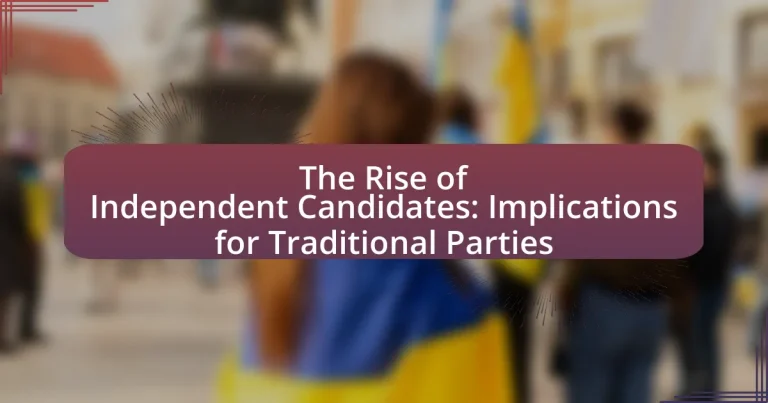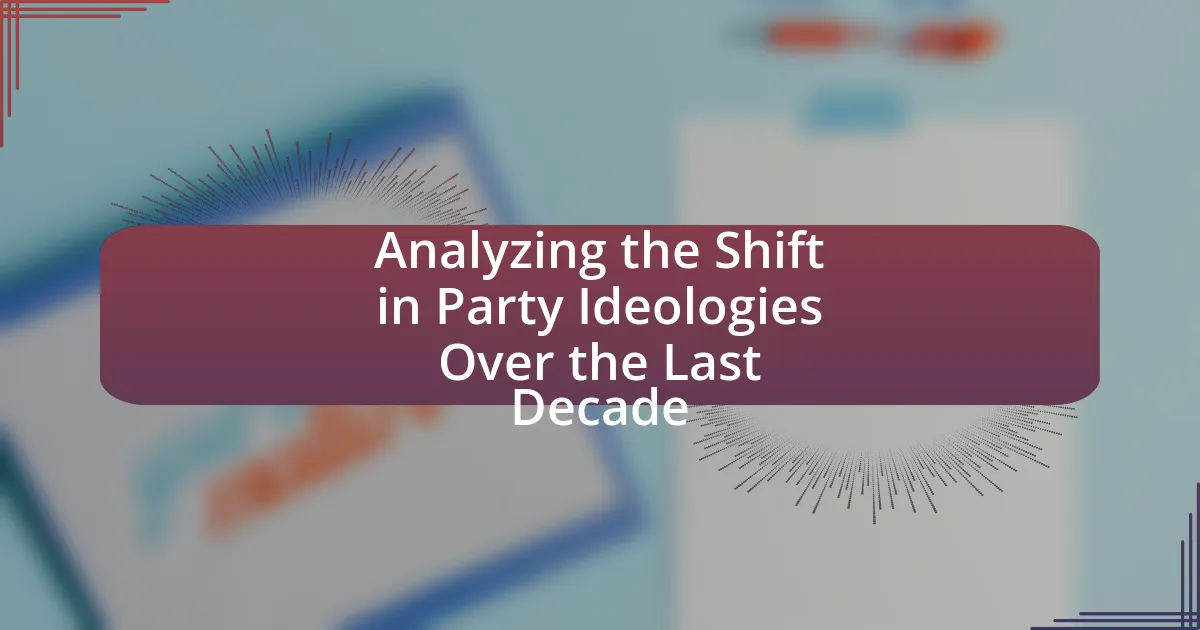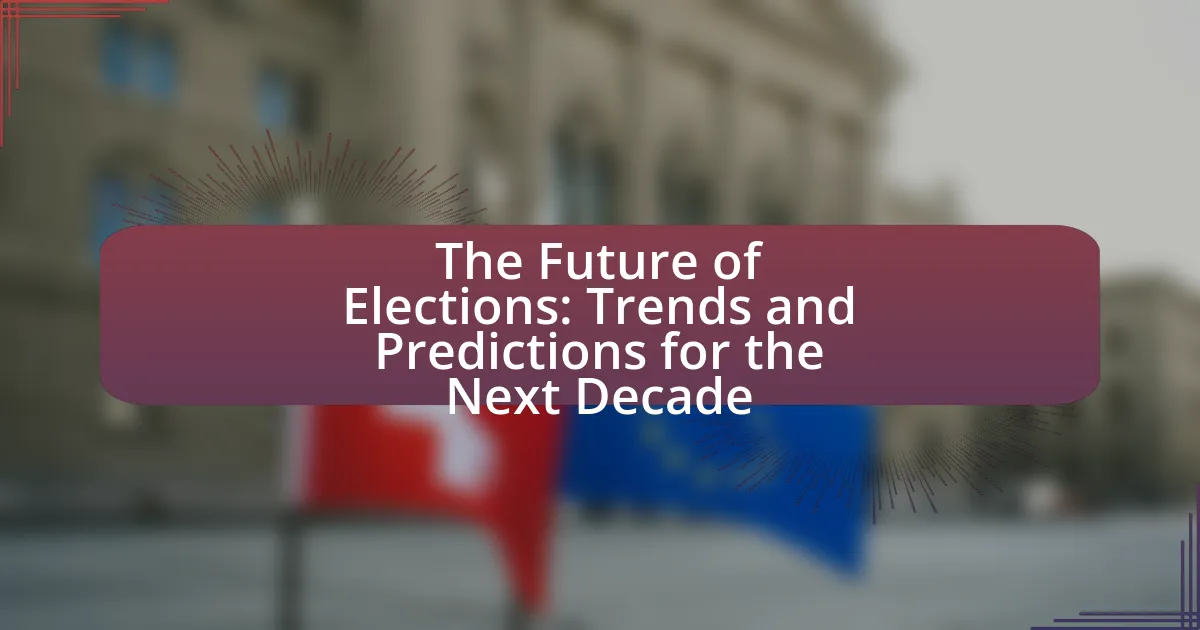The rise of independent candidates signifies a growing trend in political elections, particularly in the United States, where candidates without formal party affiliations are increasingly successful. This article explores the factors contributing to the popularity of independent candidates, including voter dissatisfaction with traditional parties and the effective use of social media for direct voter engagement. It examines how independent candidates differ from traditional party candidates, their impact on the political landscape, and the implications for established parties, including challenges to their voter base and funding. Additionally, the article discusses strategies traditional parties may adopt to remain relevant in this evolving political environment.

What is the Rise of Independent Candidates?
The rise of independent candidates refers to the increasing number of political candidates who run for office without formal affiliation to established political parties. This trend has gained momentum in various electoral systems, particularly in the United States, where independent candidates have achieved notable successes in local, state, and national elections. For instance, in the 2018 midterm elections, a record number of independent candidates ran for Congress, reflecting a growing voter dissatisfaction with traditional party politics. This shift indicates a significant change in the political landscape, as independent candidates often attract voters seeking alternatives to the polarized platforms of major parties.
How have independent candidates gained popularity in recent elections?
Independent candidates have gained popularity in recent elections due to increasing voter dissatisfaction with traditional political parties. This trend is evidenced by the rise of candidates like Bernie Sanders and Jill Stein in the United States, who attracted significant support by addressing issues often overlooked by mainstream parties, such as income inequality and climate change. Additionally, the 2020 U.S. presidential election saw independent candidates receiving a combined total of over 4% of the popular vote, indicating a growing willingness among voters to consider alternatives to the two-party system. This shift reflects a broader global trend where independent candidates are capitalizing on social media platforms to engage with voters directly, bypassing traditional party structures and appealing to a more diverse electorate.
What factors contribute to the increasing support for independent candidates?
The increasing support for independent candidates is primarily driven by voter dissatisfaction with traditional political parties. This dissatisfaction stems from perceptions of corruption, lack of representation, and failure to address key issues such as healthcare, education, and economic inequality. According to a 2020 Gallup poll, 62% of Americans expressed dissatisfaction with the way the country is being governed, indicating a significant desire for alternatives to the established parties. Additionally, the rise of social media has enabled independent candidates to reach voters directly, bypassing traditional party structures and allowing for grassroots mobilization. This shift in communication has empowered candidates who can resonate with specific voter concerns, further contributing to their growing support.
How do independent candidates differ from traditional party candidates?
Independent candidates differ from traditional party candidates primarily in their lack of affiliation with established political parties. This independence allows them to present unique platforms that may not align with party ideologies, enabling them to attract voters seeking alternatives to mainstream options. For instance, in the 2016 U.S. presidential election, independent candidate Gary Johnson received nearly 4% of the popular vote, demonstrating the potential appeal of candidates outside the two-party system. Additionally, independent candidates often rely on grassroots fundraising and personal networks rather than party resources, which can lead to a more direct connection with constituents.
Why is the rise of independent candidates significant for the political landscape?
The rise of independent candidates is significant for the political landscape because it challenges the dominance of traditional political parties and reflects a growing voter dissatisfaction with established political systems. Independent candidates often attract voters who feel unrepresented by mainstream parties, as evidenced by the increasing number of voters identifying as independents, which reached 40% in the 2020 U.S. presidential election according to the Pew Research Center. This shift can lead to a fragmentation of the vote, making it more difficult for traditional parties to secure majorities and prompting them to adapt their platforms to address the concerns of a broader electorate.
What implications does this trend have for voter engagement?
The rise of independent candidates significantly enhances voter engagement by providing alternatives to traditional party candidates, thereby attracting disillusioned voters. This trend indicates that voters are increasingly seeking representation that aligns with their values rather than party affiliation, as evidenced by a 2020 Gallup poll showing that 62% of Americans believe a third party is needed. Consequently, independent candidates can mobilize previously disengaged demographics, leading to higher voter turnout and participation in elections.
How might independent candidates influence policy-making?
Independent candidates can influence policy-making by introducing alternative viewpoints and challenging the status quo of traditional party platforms. Their presence in elections often compels established parties to address issues they might otherwise overlook, as independent candidates can attract voters dissatisfied with mainstream options. For instance, in the 2016 U.S. presidential election, independent candidate Gary Johnson garnered nearly 4% of the vote, prompting major parties to reconsider their stances on issues like drug policy and civil liberties. This dynamic can lead to shifts in policy priorities and encourage bipartisan cooperation on specific issues, as traditional parties may seek to appeal to the independent voter base.
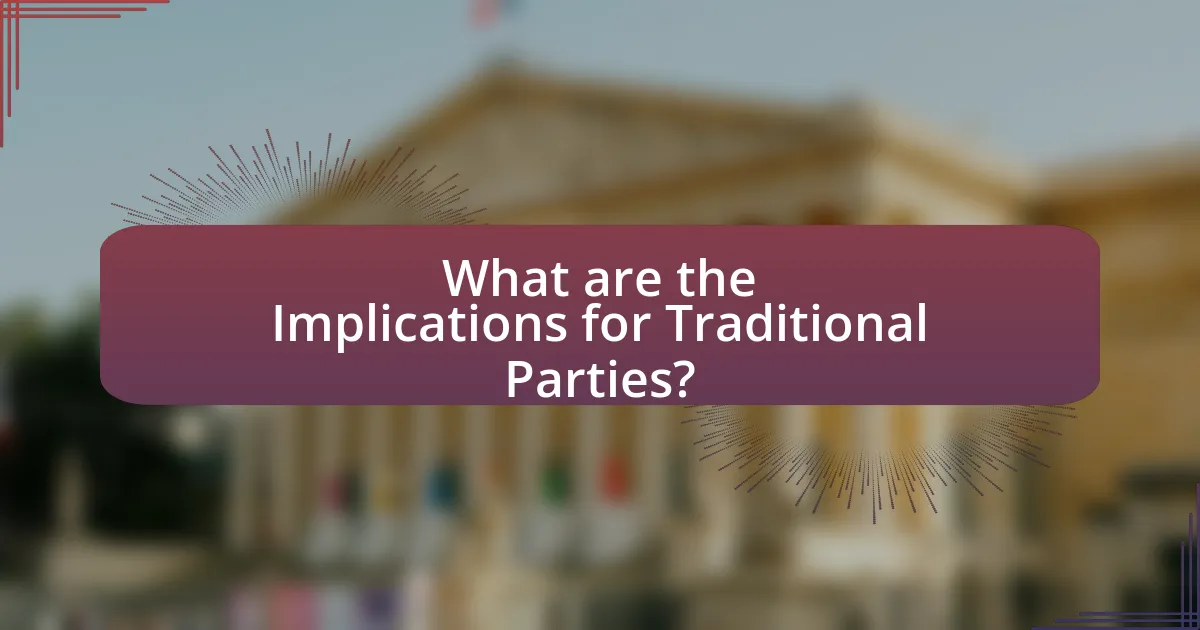
What are the Implications for Traditional Parties?
The rise of independent candidates significantly challenges traditional parties by eroding their voter base and altering electoral dynamics. Independent candidates often attract disillusioned voters who feel unrepresented by established parties, leading to a fragmentation of the political landscape. For instance, in the 2016 U.S. presidential election, independent candidates like Gary Johnson and Jill Stein garnered nearly 5% of the popular vote, illustrating their potential to siphon votes away from major party candidates. This shift can compel traditional parties to reassess their platforms and strategies to regain lost support, as seen in various elections where parties have adopted more centrist or populist positions in response to independent candidacies.
How are traditional parties responding to the rise of independent candidates?
Traditional parties are increasingly adapting their strategies in response to the rise of independent candidates. They are enhancing their outreach efforts to engage voters who may be disillusioned with established party politics, often by adopting more populist messaging and focusing on local issues that resonate with constituents. For instance, in the 2020 U.S. elections, traditional parties recognized the threat posed by independent candidates and began to prioritize grassroots campaigns and community engagement initiatives to reclaim voter trust and support. This shift is evidenced by the increased funding and resources allocated to local campaigns, as well as the incorporation of more flexible platforms that address the concerns of independent voters.
What strategies are traditional parties adopting to retain voters?
Traditional parties are adopting strategies such as enhancing voter engagement through grassroots campaigns and leveraging digital platforms to communicate directly with constituents. These approaches aim to build stronger relationships with voters and address their concerns more effectively. For instance, many traditional parties are utilizing social media to disseminate information quickly and interactively, which has been shown to increase voter participation and loyalty. Additionally, some parties are focusing on policy adjustments that resonate with the electorate’s evolving priorities, such as climate change and economic inequality, to remain relevant and appealing.
How do independent candidates challenge the platforms of traditional parties?
Independent candidates challenge the platforms of traditional parties by presenting alternative viewpoints and policies that resonate with voters disillusioned by mainstream options. They often address specific issues that traditional parties overlook, such as local concerns or niche topics, thereby attracting a dedicated voter base. For instance, in the 2016 U.S. presidential election, independent candidate Bernie Sanders gained significant support by advocating for universal healthcare and income inequality, issues that were not prioritized by the Democratic Party establishment. This ability to tap into unmet voter needs demonstrates how independent candidates can disrupt the political landscape and compel traditional parties to reconsider their platforms to remain competitive.
What risks do traditional parties face due to the rise of independent candidates?
Traditional parties face significant risks due to the rise of independent candidates, primarily including the erosion of their voter base and the fragmentation of political support. Independent candidates often attract disillusioned voters who may feel that traditional parties do not represent their interests, leading to a decrease in electoral support for established parties. For instance, in the 2016 U.S. presidential election, independent candidates garnered nearly 5% of the popular vote, indicating a notable shift in voter preferences away from traditional party lines. This trend can weaken traditional parties’ influence and reduce their ability to secure majorities in elections, ultimately threatening their political viability.
How could the emergence of independent candidates affect party funding?
The emergence of independent candidates could significantly reduce party funding by diverting financial support away from traditional political parties. As independent candidates gain traction, they may attract donations that would typically go to established parties, leading to a decrease in their overall funding. For instance, in the 2016 U.S. presidential election, independent candidate Gary Johnson received over 4 million votes, demonstrating the potential for independents to draw support from party loyalists. This shift can create a competitive funding environment where parties must adapt their fundraising strategies to retain donor interest and support.
What impact might this trend have on party unity and cohesion?
The rise of independent candidates may significantly weaken party unity and cohesion. As independent candidates attract voters who might otherwise support traditional parties, this trend can lead to fragmentation within party ranks, causing internal divisions and reducing collective action. For instance, in the 2018 U.S. midterm elections, independent candidates garnered over 20% of the vote in several districts, illustrating their potential to disrupt established party dynamics. This shift can result in traditional parties losing their influence and facing challenges in maintaining a unified front on key issues, ultimately undermining their effectiveness in governance.
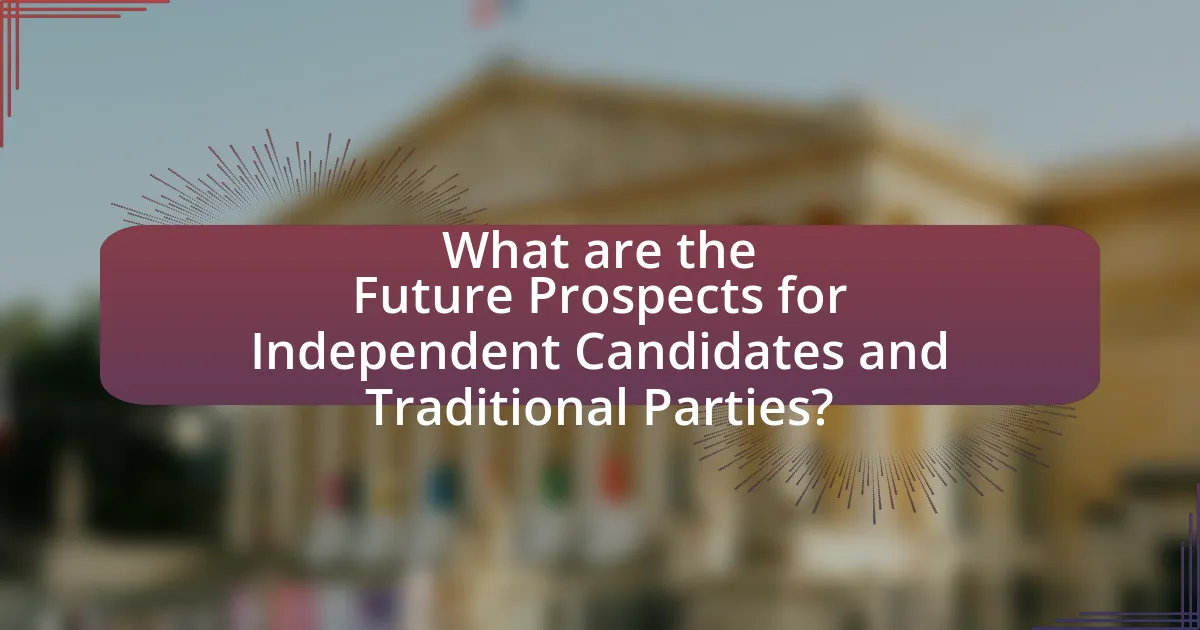
What are the Future Prospects for Independent Candidates and Traditional Parties?
The future prospects for independent candidates appear promising, while traditional parties may face significant challenges. Independent candidates have gained traction in recent elections, reflecting a growing voter dissatisfaction with established parties. For instance, in the 2020 U.S. presidential election, independent candidates received approximately 3% of the total vote, indicating a shift in voter preferences. Traditional parties, on the other hand, are experiencing declining membership and voter loyalty, as evidenced by a Gallup poll showing that only 25% of Americans identified with the Democratic Party and 27% with the Republican Party in 2021, the lowest levels in decades. This trend suggests that independent candidates may continue to disrupt the political landscape, compelling traditional parties to adapt or risk further marginalization.
How might the political landscape evolve with the continued rise of independent candidates?
The political landscape may evolve towards increased fragmentation and polarization with the continued rise of independent candidates. As independent candidates gain traction, they challenge the dominance of traditional parties, leading to a more diverse array of political voices and potentially altering voter alignment. For instance, in the 2020 U.S. presidential election, independent candidates garnered approximately 3% of the popular vote, indicating a growing willingness among voters to support alternatives to the two-party system. This trend could result in traditional parties adapting their platforms to appeal to a broader electorate or facing diminished influence in key elections.
What potential changes could occur in electoral systems as a result?
Electoral systems could undergo significant changes, such as the introduction of ranked-choice voting and proportional representation, in response to the rise of independent candidates. These changes aim to accommodate a broader spectrum of political views and reduce the dominance of traditional parties. For instance, ranked-choice voting allows voters to rank candidates, which can lead to more diverse representation and encourage independent candidates to run, as seen in jurisdictions like Maine, where this system has been implemented. Additionally, proportional representation systems, used in countries like Germany, can provide a more accurate reflection of voter preferences, enabling independent candidates to gain seats in legislative bodies. These adaptations reflect a shift towards inclusivity and responsiveness in electoral processes.
How can traditional parties adapt to remain relevant in this changing environment?
Traditional parties can adapt to remain relevant in a changing environment by embracing digital engagement and focusing on grassroots movements. Digital platforms allow parties to connect with younger voters and facilitate real-time communication, which is essential as independent candidates often leverage social media effectively. For instance, a Pew Research Center study indicates that 69% of adults in the U.S. use social media, highlighting its importance in modern political campaigns. Additionally, traditional parties can prioritize local issues and community involvement, as evidenced by the success of independent candidates who often resonate more with constituents by addressing specific regional concerns. By integrating these strategies, traditional parties can enhance their appeal and competitiveness in the evolving political landscape.
What best practices can traditional parties adopt to engage with independent-minded voters?
Traditional parties can engage with independent-minded voters by prioritizing issue-based campaigning and fostering open dialogue. By focusing on specific issues that resonate with these voters, such as healthcare, education, and economic opportunity, parties can demonstrate their relevance and responsiveness to the concerns of the electorate. Research indicates that independent voters often prioritize candidates who address their specific needs rather than party affiliation, as shown in the 2020 election where 50% of independents reported that they were more influenced by candidate positions than party loyalty. Additionally, traditional parties should utilize social media platforms to create interactive forums for discussion, allowing independent voters to voice their opinions and feel heard. This approach not only builds trust but also encourages engagement by making voters feel like active participants in the political process.
How can traditional parties leverage social media to connect with voters?
Traditional parties can leverage social media to connect with voters by creating targeted content that resonates with specific demographics. By utilizing data analytics, parties can identify voter preferences and tailor their messaging accordingly, ensuring that their communications are relevant and engaging. For instance, a study by the Pew Research Center found that 69% of adults in the U.S. use social media, making it a crucial platform for reaching a broad audience. Additionally, traditional parties can engage in two-way communication through social media, allowing voters to interact directly with party representatives, which fosters a sense of community and trust. This approach has been shown to increase voter engagement and participation, as evidenced by the 2016 U.S. presidential election, where candidates who effectively used social media saw higher levels of voter mobilization.
What role does grassroots campaigning play in appealing to independent voters?
Grassroots campaigning plays a crucial role in appealing to independent voters by fostering personal connections and emphasizing local issues. This approach allows candidates to engage directly with constituents, creating a sense of community and trust that resonates with independents, who often prioritize authenticity and relatability over party affiliation. Research indicates that independent voters are more likely to support candidates who demonstrate a commitment to grassroots efforts, as these campaigns often reflect a candidate’s responsiveness to the electorate’s needs. For instance, a study by the Pew Research Center found that 60% of independent voters value candidates who engage in local outreach and community involvement, highlighting the effectiveness of grassroots strategies in mobilizing this demographic.
